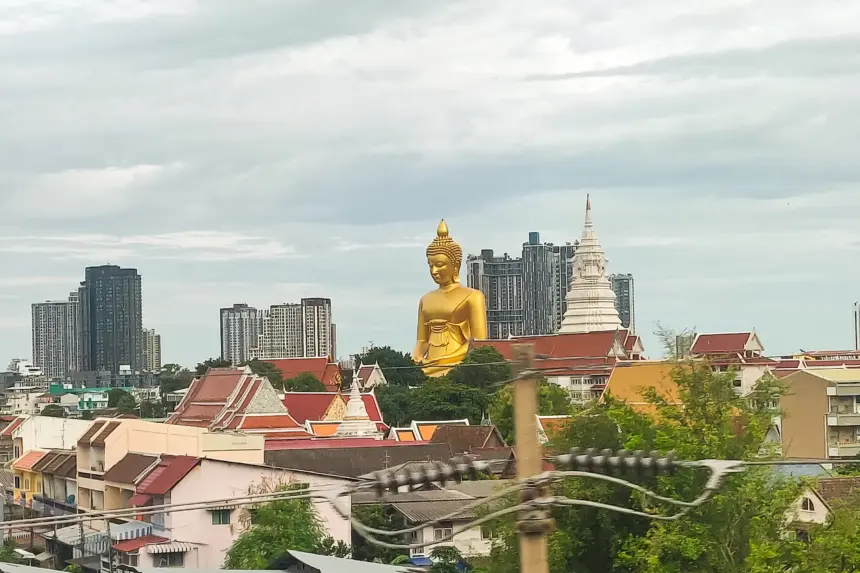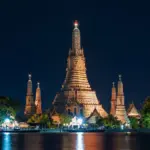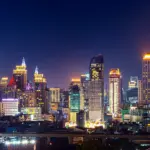The Big Buddha at Paknam Temple: A Towering Symbol of Faith and Reverence in Bangkok
In the vibrant city of Bangkok, where modern skyscrapers stand side by side with ancient temples, the Big Buddha at Paknam Temple has emerged as one of the most striking and spiritually significant landmarks. Officially known as “Phra Buddha Dhammakāya Thepmongkhon” this massive statue is a beacon of Buddhist faith, towering over the Chao Phraya River and offering a profound sense of peace and reverence to all who visit. This article delves into the history, architectural significance, cultural importance, and visitor experience of the Big Buddha at Paknam Temple, illustrating why this monumental statue has become an essential part of Bangkok’s spiritual landscape.
The Historical Background of Paknam Temple
Paknam Temple, or Wat Paknam Phasi Charoen, has a rich history that dates back more than 400 years. Located in the Phasi Charoen district of Bangkok, the temple was originally established during the Ayutthaya period, one of Thailand’s most prosperous eras. The temple’s name, “Paknam,” means “river mouth,” reflecting its location near the confluence of several canals and its historical importance as a spiritual center for the local community.
Over the centuries, Wat Paknam has played a significant role in Thai Buddhism, serving as a place of meditation, learning, and religious observance. The temple became particularly renowned in the 20th century under the leadership of the revered monk Luang Pu Sodh Candasaro, who was instrumental in revitalizing the practice of Dhammakaya meditation—a form of meditation that emphasizes inner light and mindfulness. Luang Pu Sodh’s teachings attracted thousands of followers, and Wat Paknam became a hub for Buddhist practice and education.
The Vision Behind the Big Buddha
The idea to construct the Big Buddha at Paknam Temple was conceived in the early 21st century as part of a broader vision to create a lasting symbol of Buddhism in Bangkok. The project was initiated by the temple’s current abbot, Phra Maharaj Dhammajayo, who sought to honor the teachings of the Buddha and inspire future generations of Buddhists. The statue was also intended to commemorate the contributions of Luang Pu Sodh and to serve as a spiritual landmark that would draw both devotees and tourists from around the world.
Construction of the Big Buddha began in 2008, and the project was completed in 2017. The statue was funded entirely by donations from Buddhists and supporters of Wat Paknam, reflecting the deep reverence and devotion that the temple inspires. Upon its completion, the Big Buddha became one of the tallest Buddha statues in Thailand and a new symbol of Bangkok’s religious and cultural heritage.
Architectural and Artistic Significance
The Big Buddha at Paknam Temple is an architectural marvel, combining traditional Buddhist iconography with modern engineering. Standing at an impressive height of 69 meters (226 feet) and with a width of 40 meters (131 feet), the statue is a colossal representation of the Buddha in the seated meditation posture, known as “Māravijaya,” symbolizing the Buddha’s victory over the temptations of Mara, the demon of illusion.
The Design and Construction Process
The statue was meticulously designed to ensure both its spiritual significance and structural integrity. The core of the statue is made of reinforced concrete, while the outer surface is covered with gilded bronze, giving the statue its radiant golden appearance. The decision to use bronze was made to ensure durability and to create a surface that would reflect sunlight, symbolizing the Buddha’s enlightenment and the spread of his teachings.
The statue’s face and hands were carefully sculpted to convey a sense of serenity and compassion, qualities that are central to Buddhist teachings. The eyes of the Buddha are slightly downcast, suggesting introspection and mindfulness, while the hands rest gently in the lap in the Dhyana Mudra, a gesture of meditation and concentration.
The construction process was a massive undertaking, involving skilled artisans, engineers, and architects who worked tirelessly to bring the vision to life. The statue’s size and weight required innovative engineering solutions, including a robust foundation that could support the immense structure and resist the forces of nature, such as wind and rain.
The Base and Surrounding Structures
The Big Buddha is seated on a multi-tiered base that houses a museum and a meditation hall. The base itself is intricately decorated with traditional Thai motifs, including lotus petals, which are a symbol of purity in Buddhism, and depictions of the Buddha’s life and teachings. Visitors can enter the base to view exhibits on the history of Wat Paknam, the life of Luang Pu Sodh, and the construction of the Big Buddha.
The surrounding area of the temple complex has also been beautifully landscaped, with gardens, ponds, and smaller statues that enhance the spiritual ambiance of the site. These elements create a serene environment that invites reflection and meditation, making the temple a peaceful retreat from the hustle and bustle of Bangkok.
Cultural and Religious Importance
The Big Buddha at Paknam Temple is not just a stunning piece of art; it is also a powerful symbol of faith and a focal point for religious activity. The statue has quickly become a pilgrimage site for Buddhists from Thailand and around the world, who come to pay their respects, offer prayers, and seek blessings.
A Symbol of Buddhist Values
The Big Buddha embodies the core values of Buddhism—compassion, wisdom, and mindfulness. It serves as a reminder of the Buddha’s teachings and the path to enlightenment. The statue’s serene expression and meditative posture encourage visitors to cultivate inner peace and mindfulness in their own lives, reflecting the Buddha’s example.
The statue is also seen as a symbol of unity within the Buddhist community, as its construction was made possible through the collective efforts and donations of thousands of individuals. This collective action mirrors the Buddhist concept of “Sangha,” the community of monks, nuns, and laypeople who practice and uphold the teachings of the Buddha.
Religious Activities and Festivals
Throughout the year, Wat Paknam hosts a variety of religious ceremonies and festivals that draw large crowds of devotees. These events often take place at the base of the Big Buddha, where monks lead prayers, chants, and meditation sessions. The statue serves as a spiritual focal point during these gatherings, enhancing the sense of reverence and community among participants.
One of the most significant events is the annual Visakha Bucha Day celebration, which commemorates the birth, enlightenment, and passing of the Buddha. On this day, thousands of Buddhists gather at Wat Paknam to participate in candlelit processions, offer flowers and incense, and reflect on the teachings of the Buddha. The sight of the Big Buddha illuminated by thousands of candles is a powerful and moving experience that leaves a lasting impression on all who attend.
Visitor Experience
Visiting the Big Buddha at Paknam Temple is a unique and memorable experience that offers a deep connection to Thailand’s spiritual and cultural heritage. The statue’s immense size and tranquil presence make it a striking sight, whether viewed up close or from a distance.
Getting to Wat Paknam
Wat Paknam is located in the Phasi Charoen district of Bangkok, a short distance from the Chao Phraya River. The temple is easily accessible by taxi, boat, or the BTS Skytrain, with the nearest station being Bang Wa. From there, visitors can take a short taxi or motorbike ride to the temple.
Exploring the Temple Grounds
Upon arrival, visitors are greeted by the impressive sight of the Big Buddha towering above the temple grounds. The statue is visible from many parts of Bangkok, but seeing it up close is a truly awe-inspiring experience. Visitors can walk around the base of the statue, take in the intricate details of the design, and enter the museum to learn more about the temple’s history and the construction of the Buddha.
The temple grounds also offer plenty of opportunities for quiet reflection and meditation. The gardens and ponds surrounding the statue provide a peaceful setting, where visitors can sit, relax, and absorb the serene atmosphere. The temple’s meditation hall is open to visitors who wish to practice mindfulness or simply enjoy a moment of tranquility.
Practical Information for Visitors
Wat Paknam is open to visitors every day from early morning until late afternoon. There is no entrance fee, but donations are appreciated and help support the temple’s upkeep and activities. Visitors are encouraged to dress modestly, covering their shoulders and knees, as a sign of respect for the sacred site. Photography is allowed, but visitors should be mindful not to disturb those who are praying or meditating.
Conclusion
The Big Buddha at Paknam Temple is more than just a monumental statue; it is a powerful symbol of faith, compassion, and the enduring legacy of Buddhism in Thailand. As one of Bangkok’s most significant religious landmarks, the Big Buddha attracts visitors from all walks of life, offering a place for reflection, inspiration, and spiritual growth. Whether you are a devout Buddhist, a curious traveler, or an admirer of art and architecture, a visit to the Big Buddha at Paknam Temple is an unforgettable experience that captures the essence of Thailand’s rich cultural and spiritual heritage.-









